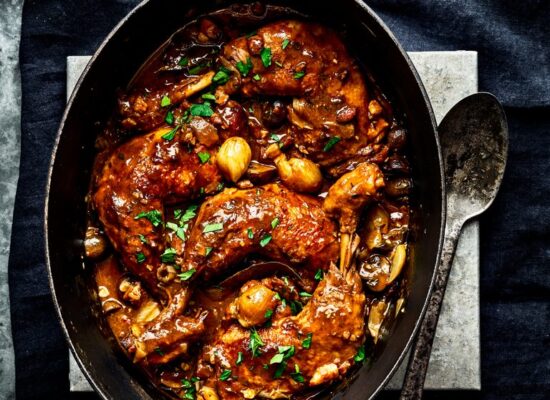Escargot, or snails cooked in garlic butter, is a classic French delicacy often enjoyed as an appetizer. Here’s a detailed recipe to make Escargot at home:
Ingredients
For the Garlic Butter:
- 1/2 cup (1 stick) unsalted butter, softened
- 4 cloves garlic, minced
- 2 tablespoons fresh parsley, finely chopped
- 1 tablespoon fresh lemon juice
- 1/4 teaspoon salt
- 1/4 teaspoon ground black pepper
For the Escargot:
- 24 canned or jarred snails, rinsed and drained
- 24 snail shells (optional, can be found in specialty stores or online)
- 1 baguette, sliced (for serving)
Instructions
1. Prepare the Garlic Butter:
- Mix Ingredients: In a medium bowl, combine the softened butter, minced garlic, chopped parsley, lemon juice, salt, and pepper. Mix well until all ingredients are fully incorporated.
- Refrigerate: Place the garlic butter in the refrigerator to firm up slightly while preparing the snails.
2. Preheat the Oven:
- Preheat: Preheat your oven to 375°F (190°C).
3. Prepare the Snails:
- Fill Shells: If using snail shells, place a small amount of garlic butter in the bottom of each shell. Insert a snail into each shell, then fill the rest of the shell with more garlic butter. Make sure the snail is fully encased in the butter.
- Alternative Method: If not using shells, you can place the snails in a snail dish or small oven-safe dish and cover each one with a generous amount of garlic butter.
4. Bake the Escargot:
- Bake: Place the filled snail shells or dish in the preheated oven and bake for 10-12 minutes, or until the garlic butter is bubbling and the snails are heated through.
- Broil (Optional): For a slightly crispy top, you can broil the snails for an additional 1-2 minutes, keeping a close eye to prevent burning.
5. Serve:
- Presentation: Serve the escargot immediately while still hot. Use snail dishes or small individual dishes for an authentic presentation.
- Accompaniments: Offer slices of fresh baguette to complement the escargot, perfect for sopping up the delectable garlic butter.
Tips:
- Shells: Snail shells enhance the traditional experience but are not mandatory. The dish can be equally enjoyed by baking the snails directly in garlic butter.
- Garlic Butter Flavoring: The seasoning of the garlic butter is crucial as it imparts most of the flavor to the snails. Ensure it is well-seasoned according to your taste preferences.
- Immediate Serving: Escargot should be served hot to appreciate its full flavor, accompanied by crusty bread that pairs wonderfully with the creamy, flavorful butter.
Delight in the rich and exquisite taste of homemade Escargot, a dish that not only satiates the palate but also brings a touch of French elegance to your dining experience.


















































